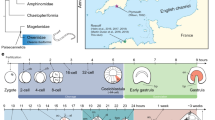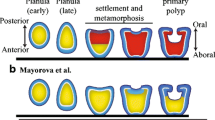Abstract
Early embryogenesis in nematodes as seen in Caenorhabditis elegans and many other species of this phylum features several characteristic events. These include the visible presence of a germline from the very beginning generating different somatic lineages via asymmetric cleavages, the absence of a coeloblastula and a unique type of gastrulation with immigration of just two gut precursor cells. Here it is shown by using Nomarski optics that development of the freshwater nematode Tobrilus diversipapillatus differs from this pattern in two prominent aspects. (1) No asymmetric cleavages and no distinct cell lineages are generated; (2) in contrast to all other nematodes studied so far, a prominent coeloblastula is formed and gastrulation resembles the “classical” pattern found all over the animal kingdom. These developmental peculiarities are considered to be plesiomorphic and thus the order “Triplonchida”, to which Tobrilus belongs, may occupy a phylogenetic position at the base of the nematode phylum. The findings reported here allow us to reject a number of conceivable correlations between the type of gastrulation and other developmental parameters.




Similar content being viewed by others
References
Aleshin VV, Kedrova OS, Milyutina IA, Vladychenskaya NS, Petrov NB (1998) Relationships among nematodes based on the analysis of 18S rRNA gene sequences: molecular evidence for monophyly of Chromadorian and Secernentean nematodes. Russ J Nematol 6:175–184
Arendt D (2004) Comparative aspects of gastrulation. In: Stern CD (ed) Gastrulation—from cells to embryo. Cold Spring Harbor Laboratory Press, New York, pp 679–693
Blaxter ML, De Ley P, Garey JR, Liu LX, Scheldeman P, Vierstraete A, Vanfleteren JR, Mackey LY, Dorris M, Frisse LM, Vida JT, Thomas WK (1998) A molecular evolutionary framework for the phylum Nematoda. Nature 392:71–75
Boveri T (1899) Die Entwicklung von Ascaris megalocephala mit besonderer Rücksicht auf die Kernverhältnisse. Festschrift C von Kupffer. Fischer, Jena, pp 383–430
Brusca GJ, Brusca RC, Gilbert SF (1997) Characteristics of metazoan development In: Gilbert SF, Raunio AM (eds) Embryology constructing the organism. Sinauer, Sunderland, Mass., pp 3–19
De Ley P, Blaxter M (2002) Systematic position and phylogeny. In: Lee DL (ed) The biology of nematodes. Taylor and Francis, London, pp 1–30
Drosdovsky EM (1977) Characteristics of the ovum cleavage and the importance of the preblastula phase in the embryogenesis of the Nematoda (in Russian). Arch Anat Histol Embryol 73:88–94
Hope IA (2002) Embryology, developmental biology and the genome. In: Lee DL (ed) The biology of nematodes. Taylor and Francis, London, pp 121–145
Lahl V, Halama C, Schierenberg E (2003) Comparative and experimental embryology of Plectidae (Nematoda). Dev Genes Evol 213:18–27
Laugsch M, Schierenberg E (2004) Differences in maternal supply and early development of closely related nematode species. Int J Dev Biol 48:655–662
Malakhov VV (1994) Nematodes, structure, development, classification and phylogeny. Smithsonian Institution Press, Washington, D.C.
Nance J, Priess JR (2002) Cell polarity and gastrulation in C. elegans. Development 129:387–397
Raff RA (1996) The shape of life. University of Chicago Press, Chicago
Schierenberg E, Lahl V (2004) Embryology and phylogeny of nematodes In: Cook RC, Hunt DJ (eds) Nematology monographs and perspectives, vol 2. Brill, Leiden, pp 667–679
Skiba F, Schierenberg E (1992) Cell lineages, developmental timing, and spatial pattern formation in embryos of free-living soil nematodes. Dev Biol 151:597–610
Sulston JE, Schierenberg E, White JG, Thomson JN (1983) The embryonic cell lineage of the nematode C. elegans. Dev Biol 100:64–119
Tahseen Q, Ahmad I, Jairajpuri MS (1993) SEM observations and developmental biology of Tobrilus paludicola Micoletzky, 1925 (Nematoda: Enoplida). Nematologica 39:512–520
Voronov DA (1999) The embryonic development of Pontonema vulgare (Enoplida: Oncholaimidae) with a discussion of nematode phylogeny. Russ J Nematol 7:105–114
Voronov DA, Panchin Y (1998) Cell lineage in marine nematode Enoplus brevis. Development 125:143–150
Wolpert L (1986) From egg to embryo: determinative events in early development. Cambridge University Press, Cambridge
Acknowledgements
Most of the work described here was done during a sabbatical stay in the Department of Nematology, University of California, Riverside. I thank the Heinrich-Hertz-Stiftung, Düsseldorf, for financial support and members of the De Ley laboratory for hospitality and advice, Paul De Ley for species identification, Vladimir Malakhov, Michael Kroiher and Jens Schulze for discussion, P.D.L. and Randy Cassada for useful comments, and Margarete Schierenberg for invaluable help in isolating nematodes.
Author information
Authors and Affiliations
Corresponding author
Additional information
Edited by D. Tautz
Rights and permissions
About this article
Cite this article
Schierenberg, E. Unusual cleavage and gastrulation in a freshwater nematode: developmental and phylogenetic implications. Dev Genes Evol 215, 103–108 (2005). https://doi.org/10.1007/s00427-004-0454-9
Received:
Accepted:
Published:
Issue Date:
DOI: https://doi.org/10.1007/s00427-004-0454-9




